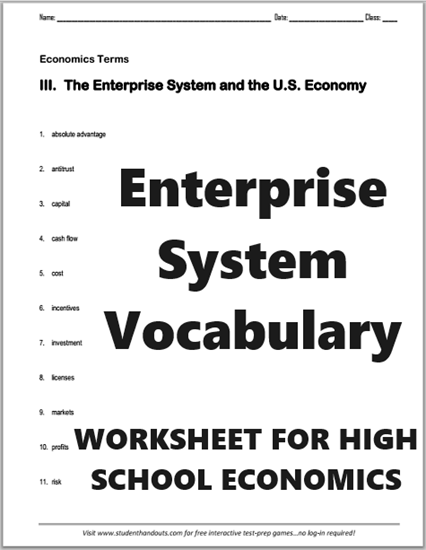| Enterprise System Vocabulary |
|---|
| www.studenthandouts.com > Social Studies > Economics > U.S. Economy and Enterprise |
 |
 |
|---|
|
Click here to print. Terms: absolute advantage, antitrust, capital, cash flow, cost, incentives, investment, licenses, markets, profits, risk. Answers will vary.
Absolute Advantage: Absolute advantage refers to the ability of a person, company, or country to produce a good or service more efficiently than competitors, using the same amount or fewer resources. This efficiency leads to higher productivity and potentially lower costs. Ask students to name companies that have an absolute advantage, and to explain why. Antitrust: Antitrust laws are regulations designed to promote competition and prevent monopolies. These laws prohibit practices such as price-fixing, collusion, and mergers that could reduce competition, ensuring fair market conditions and protecting consumers from unfair business practices. Most high school students taking this course will have already covered the relevant legislation in their earlier U.S. History course(s). Teachers would do well to refresh their students' memories on the motivations behind such legislation, in order to help their students grasp the concept of antitrust outside of a limiting theoretical framework. Capital: Capital refers to financial assets or resources that businesses use to fund operations, expand, and invest in new projects. It includes money, machinery, buildings, and other valuable assets essential for generating income and growth. Many students (and people in general) make the easy mistake of forgetting that capital is required for capitalism to function. Teachers should stress to students that "money" and "capital" are quite different things; that merely having an amount in savings does not make one a capitalist per se. And although this idea is better expounded upon in the section on labor and business, students should be aware that the term capitalism applies exclusively to businesses with employees. For example, a person running a home business can spend capital to but new equipment; but until that entrepreneur hires employees to do the work needed to expand the businesses, that person is not technically a capitalist. An easy way for students to think of it is, quite simply, that a single person can do only so much, regardless of the equipment and knowledge at the person's disposal; the true expansion (as opposed to mere increased production) of capitalism cannot occur until the businessperson employs laborers to do the work. That is, true capitalists hire others to do the "work-work" for them. Cash Flow: Cash flow is the net amount of cash and cash-equivalents moving in and out of a business. Positive cash flow indicates that a company's liquid assets are increasing, while negative cash flow suggests more cash is leaving the business than entering it. This economics concept comes up many times in the course, and is a favorite topic among students because it covers not only their personal entrepreneurial ambitions, but their personal budgets. Teachers who can get their students to grasp the importance of having more money coming in than going out, will do these students a lifetime of good. Cost: Cost represents the amount of money required to produce a good or service. It includes expenses for materials, labor, overhead, and other inputs necessary for production. Understanding costs is crucial for pricing and profitability analysis. For students with entrepreneurial goals, a helpful activity is to add up the operating costs for a proposed enterprise. Incentives: Incentives are rewards or penalties that motivate individuals or businesses to behave in certain ways. They can be financial, such as bonuses or taxes, or non-financial, such as recognition or penalties, and are used to influence decision-making and performance. Ask students to find recent news articles on business tax breaks and penalties, and to follow the affected companies to see the impact of these incentives. Investment: Investment involves allocating resources, usually money, with the expectation of generating future profit or income. It can be made in various assets, including stocks, bonds, real estate, or business ventures, aiming for capital appreciation or income generation. Consider having students compare the investments of mutual funds versus those of hedge funds. Licenses: Licenses are official permissions granted by authorities to individuals or businesses to engage in specific activities. They ensure compliance with regulations and standards, protecting public interests and ensuring fair practices in various industries. Consider assigning groups of students types of businesses, and having them research the local, state, and federal licensure requirements for each. Markets: Markets are platforms where buyers and sellers interact to exchange goods, services, or financial instruments. They can be physical locations or virtual spaces, facilitating trade and determining prices based on supply and demand dynamics. A fun project is to have students visit local malls, flea markets, holiday fairs, and the like, and research their organizational and economic structures. Profits: Profits represent the financial gain obtained when revenues exceed costs and expenses. It is a key indicator of a business's financial health and performance, reflecting the efficiency and success of its operations and strategies. Students should look at current and past trends of how corporations deal with profits. Risk: Risk refers to the possibility of loss or negative outcomes due to uncertainties or unforeseen events. It is inherent in all business and investment activities, requiring effective management to mitigate potential adverse effects and achieve desired goals. Ask students, is there truly any such thing as a "sure thing"? |
| www.studenthandouts.com > Social Studies > Economics > U.S. Economy and Enterprise |









